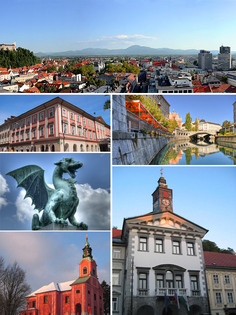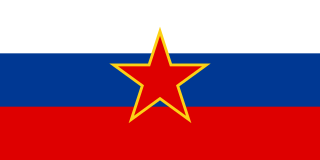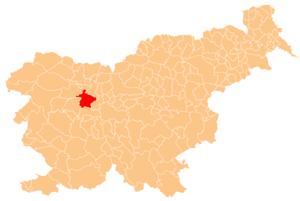
The Slovenian Armed Forces or Slovenian Army are the armed forces of Slovenia. Since 2003, it is organized as a fully professional standing army. The Commander-in-Chief of the SAF is the President of the Republic of Slovenia, while operational command is in the domain of the Chief of the General Staff of the Slovenian Armed Forces.

Slovene or Slovenian belongs to the group of South Slavic languages. It is spoken by approximately 2.5 million speakers worldwide, the majority of whom live in Slovenia. It is the first language of about 2.1 million Slovenian people and is one of the 24 official and working languages of the European Union.

Ljubljana is the capital and largest city of Slovenia. It has been the cultural, educational, economic, political, and administrative centre of independent Slovenia since 1991.

The Slovenes, also known as Slovenians, are a nation and South Slavic ethnic group native to Slovenia, and also to Italy, Austria and Hungary in addition to having a diaspora throughout the world. Slovenes share a common ancestry, culture, history and speak Slovene as their native language.

Nogometni klub Maribor, commonly referred to as NK Maribor or simply Maribor, is a professional football club based in Maribor, Slovenia, that competes in the Slovenian PrvaLiga, the top tier of Slovenian football. Nicknamed "The Purples", the club was founded on 12 December 1960. They are regarded as a symbol of Slovenian football, particularly in their home region of Styria in northeastern Slovenia.

The Slovenia national football team represents Slovenia in international football and is controlled by the Football Association of Slovenia. In the period between 1920 and 1991, Slovenia was ineligible to field a separate team for competitive matches; local players instead played for the Yugoslavia national football team. Slovenia played its first official match in 1992, one year after the country gained independence from Yugoslavia.

The Football Association of Slovenia is the governing body of football in Slovenia. It organizes the first division, second division, third division, Slovenian Cup, Slovenian Women's League, and other competitions. It is also responsible for the Slovenia national football team and the Slovenia women's national football team. It was founded as Ljubljana Football Subassociation on 23 April 1920.

Radiotelevizija Slovenija – usually abbreviated to RTV Slovenija – is Slovenia's national public broadcasting organization. Based in the country's capital, Ljubljana, it has regional broadcasting centres in Koper and Maribor and correspondents around Slovenia, Europe and the world. RTV Slovenija's national radio services operate under the name Radio Slovenija, while the television division carries the name Televizija Slovenija or TV Slovenija. The names are sometimes Anglicized as Radio Slovenia and TV Slovenia, respectively. There are three national and four regional radio services, which can all be heard online as well. RTV Slovenija also finances the RTV Slovenia Symphony Orchestra and the RTV Slovenia Big Band.

Nogometni klub Olimpija Ljubljana, commonly referred to as Olimpija Ljubljana or simply Olimpija, is a professional association football club, based in the city of Ljubljana, Slovenia. The club competes in the Slovenian PrvaLiga, the country's highest football division.

The Slovenian First Football League, currently named Prva liga Telekom Slovenije[ˈpərʋa ˈliːɡa ˈteːlɛkɔm slɔˈʋeːnijɛ] due to sponsorship reasons, also known by the abbreviation 1. SNL, is the main football league in Slovenia, and was formed in 1991 after Slovenia became an independent country. From 1920 until the end of the 1990–91 season, the Slovenian Republic League was a lower division of the Yugoslavian league football system. The league is currently governed by the Football Association of Slovenia. Between 2001 and 2012 the league was governed by the Association of 1. SNL. Celje, Gorica and Maribor are the only three clubs that have never been relegated from the league since its foundation in 1991.

The Socialist Republic of Slovenia was one of the six republics forming the post-World War II country of Yugoslavia. It existed under different names from 29 November 1945 until 25 June 1991. In 1990, while the country was still a part of the Yugoslav federation, the League of Communists of Slovenia allowed for the establishment of other political parties, which led to the democratization of the country. The official name of the republic was Federal Slovenia until 20 February 1946, when it was renamed the People's Republic of Slovenia. It retained this name until 9 April 1963, when its name was changed again, this time to Socialist Republic of Slovenia. On 8 March 1990, the Socialist Republic of Slovenia removed the prefix "Socialist" from its name, becoming the Republic of Slovenia, though remaining a constituent state of the Socialist Federal Republic of Yugoslavia until 25 June 1991, when it enacted the laws resulting in independence.

The statistical regions of Slovenia are 12 administrative entities created in 2000 for legal and statistical purposes.

Pungert is a small settlement in the Municipality of Loški Potok in southern Slovenia. The area is part of the traditional region of Lower Carniola and is now included in the Southeast Slovenia Statistical Region.
Irena Kazazić is a Slovenian painter and writer of Serbian descent.

Dolenja Brezovica is a settlement in the Municipality of Brezovica in central Slovenia. The municipality is part of the traditional region of Inner Carniola and is now included in the Central Slovenia Statistical Region.

Gabrje pri Stični is a settlement just north of Stična in the Municipality of Ivančna Gorica in central Slovenia. The area is part of the historical region of Lower Carniola. The municipality is now included in the Central Slovenia Statistical Region. The settlement includes the hamlets of Kurja Vas, Potok, Pungrt, and Nograd.

Pungert is a small settlement in the Municipality of Ivančna Gorica in central Slovenia. The area is part of the historical region of Lower Carniola. The municipality is now included in the Central Slovenia Statistical Region.
Pungert may refer to several places in Slovenia:



















